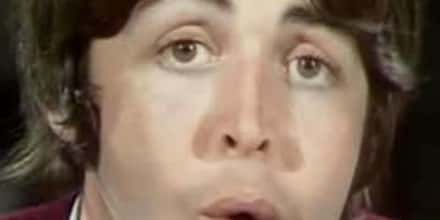Historical References In '60s And '70s Songs
Copy link
Vote up your favorite historically minded songs from the '60s and '70s.
Popular songs are often about something going on in an artist's life, but every so often, a musician or band will lay down a track that references a historical person, place, or event from the past. The artist might want to make a statement of some sort, honor (or dishonor) a famous person, remind us of where we've come from, or let us interpret the song however we want, with or without historical context.
This list features '60s and '70s songs that reference history, and some of them might surprise you.
Gordon Lightfoot didn't leave much to the imagination with “The Wreck of the Edmund Fitzgerald” because that's precisely what it's about - the 1975 sinking of the SS Edmund Fitzgerald. The song is a chronicle of the final voyage of the eponymous ship, which went down with all 29 crew members. Lightfoot was a fan of recreational sailing on the Great Lakes, so the ship's sinking hit home for the singer-songwriter.
It's forgivable for someone unfamiliar with the wreck to assume Lightfoot wrote his song about a fictional disaster, so modern audiences may not realize it's about something real. The lyrics make several assumptions about the tragedy, because he wrote it before the wreckage could be properly examined. As a result, there's some artistic license in Lightfoot's original lyrics. But he's altered some lines in subsequent live performances to accommodate for newly learned information.
For example, one verse originally said:
At 7 p.m. a main hatchway caved in
He said, “Fellas, it's been good to know ya”The investigation, however, found that a wave had led to the sinking rather than the crew forgetting to close a hatch, so Lightfoot changed the lines to:
At 7 pm, it grew dark
It was then he said, “Fellas, it's been good to know ya”- Photo:
2119 VOTES'American Pie' Is An Epic Allegory Of Rock 'n' Roll History
Don McLean's 1971 song “American Pie,” despite being decades old, continues to resonate with each new generation that listens to it. The song tells a story, and although the lyrics aren't entirely clear on their own, they line up perfectly with several historical events, essentially telling a story about the history of rock ’n’ roll.
The song's overarching historical event is the 1959 plane crash that took the lives of Buddy Holly, Ritchie Valens, and the Big Bopper. McLean describes this as “The day the music died,” effectively tying their deaths to the ending of the early era of rock ’n’ roll in America. McLean took this event as the primary inspiration for “American Pie,” which he explained in an interview with Rolling Stone:
I first found out about the plane crash because I was a 13-year-old newspaper delivery boy in New Rochelle, New York, and I was carrying the bundle of the local Standard-Star papers that were bound in twine and when I cut it open with a knife, there it was on the front page.
For McLean, “American Pie” was a kaleidoscopic description of America, which he discusses in the documentary The Day the Music Died:
It was too hard in an interview to explain the subtlety of what I was trying to say. So, I would say, "Look, I really don’t talk about the lyrics. And that’s all I would say. Because it would require a set-up such as this movie makes, for me to then come in and talk about how I lived through this.”
Many of the lyrics are cryptic but easy to decipher if analyzed independently. Some of the historical references found in the song include references to the assassinations of Martin Luther King Jr., John and Robert Kennedy, and the Vietnam War.
More American Pie- Dig Deeper...All The Cultural References In The Song ‘American Pie,' Explained
- #1 of 111 onThe Greatest One-Hit Wonder Songs of the '70s
- #13 of 122 onThe Greatest Songs by One-Hit Wonders
“Turn! Turn! Turn!” by The Byrds is taken almost entirely from the Bible's Book of Ecclesiastes. Specifically, the first eight verses come from the third chapter.
The song was written by folk musician Pete Seeger, and its most well-known recording is The Byrds' 1965 version.
Although the song isn't technically about a historical event, it uses a 3,000-year-old document of immense historical importance. The lyrics (and the verse) talk of a time and place for all things: birth, death, killing, healing, sorrow, laughter, war, and peace.
Everything has a polar opposite, and they all exist in this idealized place, which many have interpreted as a call for world peace. This is mainly due to the closing line, “A time for peace, I swear it's not too late,” which is the only line (the title as well) not taken from Ecclesiastes.
Paul Simon and Art Garfunkel's “Mrs. Robinson” was immortalized in the 1967 film The Graduate, which made Dustin Hoffman a star. Mike Nichols hired the duo to write three songs for The Graduate, but nothing worked for the director. They returned with an early version of “Mrs. Roosevelt,” which ultimately became “Mrs. Robinson.” The song fit into the film perfectly, as Garfunkel later explained:
Paul had been working on what is now “Mrs. Robinson,” but there was no name in it and we'd just fill in with any three-syllable name. And because of the character in the picture we just began using the name “Mrs. Robinson” to fit… and one day we were sitting around with Mike talking about ideas for another song. And I said, “What about Mrs. Robinson.” Mike shot to his feet. “You have a song called 'Mrs. Robinson' and you haven't even shown it to me?' So we explained the working title and sang it for him. And then Mike froze it for the picture as “Mrs. Robinson.”
Despite the name and association with The Graduate, “Mrs. Robinson” is not about a young man scoring with an older woman… At least, not entirely. The song is evocative of Joe DiMaggio and Simon's yearning for a simpler time. Simon once met the legendary ball player, and they briefly discussed the song, specifically the lyrics: “Where have you gone, Joe DiMaggio? Our nation turns its lonely eyes to you.” Later, Simon wrote about meeting the legendary athlete in a letter he penned the day DiMaggio passed:
[DiMaggio and I] immediately fell into conversation about the only subject we had in common.
"What I don't understand," he said, "is why you ask where I've gone. I just did a Mr. Coffee commercial, I'm a spokesman for the Bowery Savings Bank and I haven't gone anywhere."
I said that I didn't mean the lines literally, that I thought of him as an American hero, and that genuine heroes were in short supply. He accepted the explanation and thanked me. We shook hands and said good night.
Now, in the shadow of his passing, I find myself wondering about that explanation. Yes, he was a cultural icon, a hero if you will, but not of my generation. He belonged to my father's youth: he was a WWII guy whose career began in the days of Babe Ruth and Lou Gehrig and ended with the arrival of the youthful Mickey Mantle…
In 1973, Elton John co-wrote and performed “Candle in the Wind,” a song written to memorialize Marilyn Monroe. The opening lyrics, “Goodbye, Norma Jean,” are a giveaway if you know Monroe's real name: Norma Jean Mortenson. The song says, “Your candle burned out long before your legend ever did,” honoring her impact on history, and describes John himself, who “would have liked to know you.” Monroe perished 11 years before John co-wrote the song with Bernie Taupin.
The song's lyrics spell out the way fame builds people up and makes them the center of attention but at the cost of their lives. Monroe famously battled with depression and substance problems, and her life ended much too soon. Monroe's tragic life and end inspired the song, but it's not entirely about her. She's the song's example of a celebrity whose fame burned them out. As Taupin has explained, Monroe could be swapped out for anyone who shared her fate:
I think the biggest misconception about “Candle in the Wind’” is that I was this rabid Marilyn Monroe fanatic, which really couldn’t be further from the truth. It’s not that I didn’t have a respect for her. It’s just that the song could just as easily have been about James Dean or Jim Morrison, [or] Kurt Cobain. I mean, it could have been about Sylvia Plath or Virginia Woolf… any writer, actor, actress, or musician who died young and sort of became this iconic picture of Dorian Gray, that thing where they simply stopped aging. It’s a beauty frozen in time.
Following Princess Diana's passing in 1997, Taupin and John changed the lyrics from “Goodbye Norma Jeane” to “Goodbye England's Rose.” John performed this version of the song at Diana's service.
More Candle in the Wind- #1187 of 2,060 onThe Best Songs Of All Time, Ranked
- #23 of 72 onThe Best Ballads of the 70s
- #4 of 77 onThe Best Pop Songs About Death
- Photo:
694 VOTES'Ohio' Is A Cry Of Rage After The Kent State Shootings
Crosby, Stills, Nash & Young released “Ohio” in 1970 to protest the Kent State shootings on May 4, 1970, which occurred when the National Guard was placed on the Kent State campus to counter a rally opposing expansion of the Vietnam War into Cambodia.
Twenty-eight National Guard soldiers fired into the protesters, shooting an estimated 67 rounds in just 13 seconds. They killed four students and wounded nine others. The aftermath led to widespread protests across the country, and although the Vietnam conflict trudged on for a couple of years, the Nixon Administration took a massive hit from the incident. Crosby, Stills, Nash & Young's protest song couldn't be any more transparent, and it's been called the “greatest protest record” of the genre. The lyrics spell out precisely what the band wanted to say:
Tin soldiers and Nixon coming…
Four dead in Ohio…
Gotta get down to it, soldiers are cutting us down…
What if you knew her and found her dead on the ground
How can you run when you know
Four dead in Ohio
The last line repeats 30 times to close out the song, with various questions such as “Why?” ending each line.
Bob Dylan has never been a stranger to recording the goings-on of history and his experiences in his songs. One such recording is his 1975 hit "Hurricane." Dylan's protest song is about the imprisonment of Rubin “Hurricane” Carter, and focuses on the overtly racist actions that went into profiling the boxer. Dylan's lyrics spell this out in detail and conclude with a false trial and conviction. Perhaps the most poignant lyrics from the song that resonate today begin the story:
When a cop pulled him over to the side of the road
Just like the time before and the time before that
In Paterson, that’s just the way things go
If you’re Black, you might as well not show up on the street
‘Less you want to draw the heat
If you're Black, you might as well not show
Dylan performed “Hurricane” on December 7, 1975, at the Clinton Institution for Women, where Carson was temporarily incarcerated alongside 99 other men. Ultimately, Dylan was proven correct, as Carter's conviction for homicide was overturned following a petition of habeas corpus after he spent nearly 20 years in prison. Carter spent his time as a free man helping others who were wrongfully accused and imprisoned. He continued doing that kind of work until his passing in April 2014 at the age of 76.
More Hurricane- #30 of 156 onThe Best Bob Dylan Songs
- #4 of 12 onPop Songs That Were Ripped Straight From The Headlines
- #6 of 13 onThe Best Songs About Historical Events
“The Night They Drove Old Dixie Down,” recorded by The Band in 1969, is a first-person account of economic and societal collapses in the final year of the American Civil War. It's not about a specific historical event and is more inspired by the period. Songwriter-guitarust Robbie Robertson spent around eight months working on it. Levon Helm, The Band's drummer, wrote about the song's creation in his autobiography, This Wheel's on Fire:
Robbie and I worked on “The Night They Drove Old Dixie Down” up in Woodstock. I remember taking him to the library so he could research the history and geography of the era and make General Robert E. Lee come out with all due respect.
Robertson's work on the song made people see him as a serious songwriter. Granted, it took him longer than he might have liked to put it all together. Still, as he explained in Barney Hoskyns' Across the Great Divide: The Band and America, sometimes you just need to wait it out:
I only had the music for it, and I didn't know what it was about at all. I'd sit down at the piano and play these chords over and over again. And then, one day, the rest of it came to me. Sometimes you have to wait a song out, and I'm glad I waited for that one.
- Photo:
962 VOTES'Sail Away' Imagines Traders Of Enslaved People Enticing Africans To The New World
Randy Newman's “Sail Away,” which has since been covered by a plethora of artists including Ray Charles, Dave Matthews, and Etta James, describes the offer of a promised land to Africans who were enslaved. Rolling Stone reviewed “Sail Away” as the best track on Newman's album of the same name:
The title cut, which begins the album, is an austere ballad that carries a lovely string arrangement over a rolling, recurrent piano motif. While the music gently soars, Newman describes the American dream of a promised land as it might have been presented to Black Africa in slave-running days, but also with the full knowledge of everything to follow.
The following lyrics emphasize that “dream”:
In America, every man is free
To take care of his home and his family
You'll be as happy as a monkey in a monkey tree
You're all gonna be an American
Sail away - sail away
We will cross the mighty ocean into Charleston Bay
The song's knowing admonishment of a truly horrible period in human history makes it poignant and heartbreaking, but not by decrying it, as Newman explained to Rolling Stone in 2017:
…I had this idea of a slave ship and a sea shanty - this guy standing in a clearing, singing to a crowd of natives. These people in my songs don’t know they’re bad. They think they’re fine. I didn’t just want to say, "Slavery is awful." It’s too easy. I wasn’t doing Roots.
The Rolling Stones' “Sympathy for the Devil” was released as the opening track of the 1968 album Beggars Banquet, and it changed the Stones forever. Before the album dropped, the Stones were a lot like The Beatles in the early 1960s - clean-cut English rockers out to entertain. The album, and especially “Sympathy for the Devil,” changed all of that, and much of it had to do with the title.
The song is sung from the perspective of the Devil, making Mick Jagger his voice. The lyrics boast of the Devil's role throughout human history, beginning with the crucifixion of Jesus to the late 1960s. As he sings about humanity's historical horrors, he repeatedly asks, “Guess my name,” demanding he be treated with respect. Throughout it all, the Devil implicitly lays it all out on humanity for being wholly complicit with the horrors of our collective history.
“Sympathy for the Devil” isn't about a specific historical event but rather all the worst events to befall human history for the past 2,000 years. Ironically, the Stones were labeled as “Devil worshippers” by conservative crowds, who clearly didn't get the song's message. It's meant to be an uplifting piece about looking the Devil in the face and calling him out for everything he's done to humanity, essentially taking away his power. The lyrics are relatively tame these days, but in 1968, conservatives worldwide pointed fingers at the Stones' so-called “Sympathy for the Devil.”
“Midnight Rambler” was recorded by the Rolling Stones for their 1969 album Let It Bleed. The song's lyrics are essentially a biography of Albert DeSalvo, otherwise known as the Boston Strangler. It's a decidedly dark subject for a song, and for some reason, Mick Jagger and Keith Richards felt compelled to write it in a lovely place, as Jagger recounted in a 1995 Rolling Stone interview:
We were on a holiday in Italy. In this very beautiful hill town, Positano, for a few nights. Why we should write such a dark song in this beautiful, sunny place, I really don't know. We wrote everything there - the tempo changes, everything. And I'm playing the harmonica in these little cafes, and there's Keith with the guitar.
The song's lyrics are loosely based on DeSalvo's life, and the song's perspective is that of a murderer. It was the last song Brian Jones recorded with the Stones before leaving in June 1969; he perished the following month from a drug overdose, adding his name to the 27 Club.




























